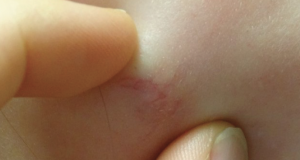Chapter 8: Lumps and Bumps
Cysts
Epidermoid Cyst
Epidermoid (epidermal inclusion) cysts are the most common cutaneous cysts. They present as skin-coloured to yellow dermal nodules often with a visible punctum. They can be up to several centimeters in size and are most common on the face and upper trunk. Non-inflamed cysts are generally asymptomatic. If the cyst wall ruptures this can cause an intense, painful inflammatory reaction. Inflamed cysts can be treated with intralesional corticosteroid injection or may require incision and drainage. If superimposed infection develops oral antibiotics may be required. Surgical excision of an epidermoid cyst is curative but it is important that the entire cyst wall is removed or else the cyst can recur.
Dermoid Cyst
Dermoid cysts occur in infancy along embryonic fusion planes on the face. Most commonly these occur around the eyes along the orbital ridge. They present as a discrete, subcutaneous nodule measuring up to 4cm in diameter. These can be treated with excision after imaging to rule out underlying connection to the CNS.
Pilomatricoma

Pilomatricoma develops from hair matrix cells. It presents as a dermal nodule that is quite hard, due to calcium with the lesion. Pilomatricomas are usually solitary but can be multilobular and rarely people can have multiple. They often have a bluish hue over the surface. They are most often seen in young children especially on the head and neck. They are generally removed surgically as they do not go away by themselves.
Milia
Milia are very common superficial cysts that occur in patients of all ages. Milia present as 1-2mm, white to yellow papules, most commonly on the face. Milia may occur as a primary processes or as a secondary phenomena in response to trauma, cosmetic procedures, or blistering disorders. They are common in infancy and are seen in increasing frequency in people with Trisomy 21. Milia can be removed by incision with a needle or scalpel and expressing the milium, or by electrodessication and laser ablation. For multiple or recurrent milia topical retinoids may be helpful. (see Ch. 9 for a photo)

